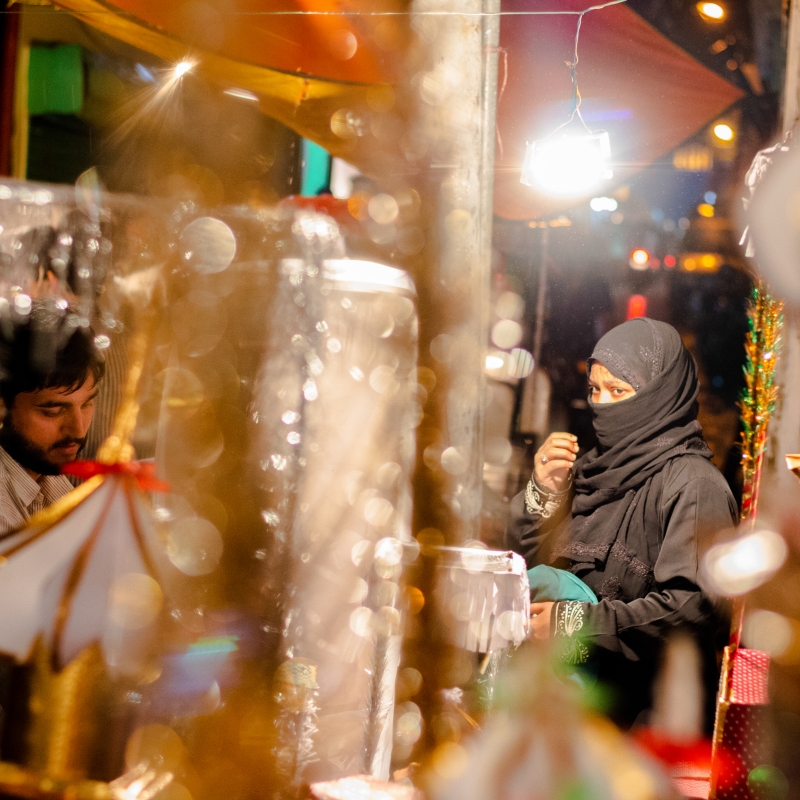‘A 15 feet taziya [symbolic representation of the mausoleum of Imam Hussain (a.s.)] made of abrak [mica flakes],’ a gentleman from Barabanki tells a taziya maker in Rudauli, Faizabad, over the phone while trying to place an order while standing in Lucknow’s Rauz-e-Kazmain (a replica of the shrine of the seventh imam, Imam Musa-al-Kazim and ninth imam, Imam-e-Jawwad). ‘But why are you after abrak, you will not get a taziya made of abrak!’ exclaims one of the 10 men accompanying the buyer. Currently, all large taziye (plural for taziya) are made from bamboo and decorated with papers or abrak, while smaller and compact taziye are made from cardboard.
Rauz-e-Kazmain is one of the major taziya making centres in Lucknow where almost all residing families are into bamboo taziya making. Men and women of the locality are equally involved in this extensive labour and creative work. Many taziya makers borrow money to arrange raw materials required in bulk and rent space in Rauz-e-Kazmain’s compound to store their taziye until sale. Some of the makers also use tarpaulin sheets to keep their creations safe from weather extremities. (Fig. 1) A well-lit taziya market is set up at Kazmain prior to the start of Muharram month. People from all walks of life frequent the market and make a purchase according to their budgets as well as azakhana (a private, temporary imambada) size
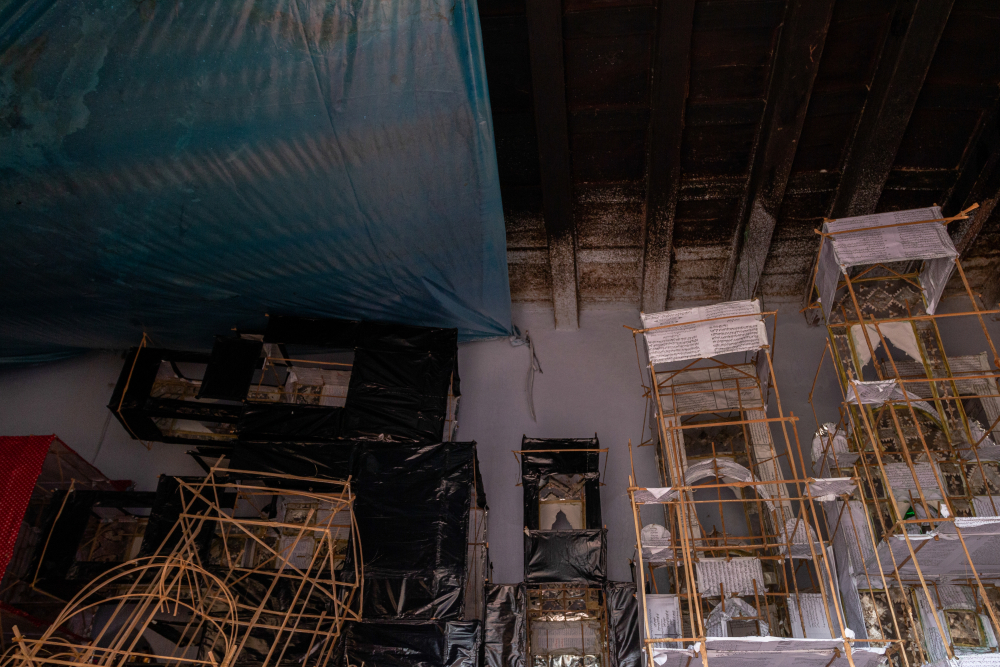
Apart from designs, pattha (vein from the dorsal of a buffalo) is a distinguishing feature of Lucknow bamboo taziya making. Pattha is sliced into thin strips to bind together bamboo sticks as it is believed to be sturdier than a thread. (Fig. 2) Hence, even though the cost of pattha keeps fluctuating, taziya makers swear by it. While traditionally pattha was a preferred binding agent used in taziye making, many taziya makers outside Lucknow have now shifted to threads soaked in Fevicol, pulp of certain fruits, and flour; this shift is visible in places such as Biswan, Bilehra and even the Chhota Imambada of Lucknow which makes the famous Shahi Zarih (shahi means royal and zarih is a larger structure similar to taziya) commissioned by Hussainabad Trust, which takes part in the city’s grand Shahi Juloos. While in most places the move away from pattha was due to its low shelf life and cost, preference for threads in Shahi Zarih is motivated by the secular nature of the Shahi Juloos where non-Muslims also come to pay their homage in Muharram processions.
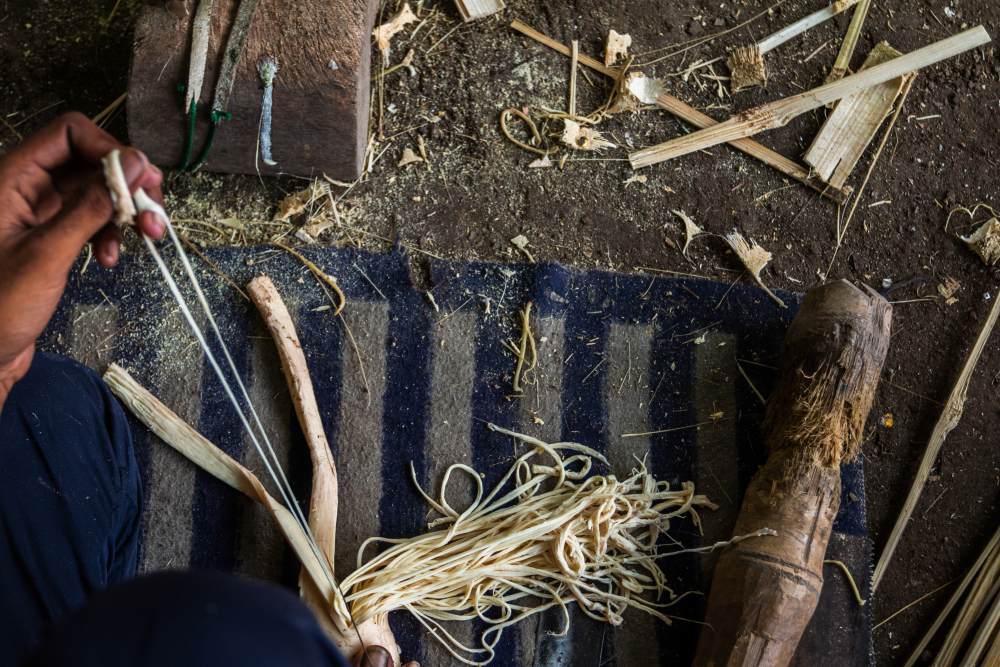
Kashmiri Mohalla and its Kamrakhi Gumzi
Lucknow’s Kashmiri Mohalla is a hub of taziya making. Many households in Kashmiri Mohalla are into the taziya trade and generations have invested themselves in making cardboard taziya. Months before Muharram, taziya makers start work; while women especially work from home and play an integral part in embellishing the taziye, many male taziya makers now work out of workshops. (Fig. 3) Many aari-zardozi (chain stitch embroidery) artists also temporarily take up taziya making due to the steady profit the profession makes during the Muharram season.
What sets apart Kashmiri Mohalla’s taziye from the others is the kamrakhi gumzi (starfruit shaped dome) taziya. (Fig. 4) The kamrakhi gumzi design was introduced by taziya maker Sikander Mirza about 50 years ago; now his sons and extended family as well as other taziya makers imbibe this feature in their taziya, making it a Lakhnavi (Lucknow style) feature.
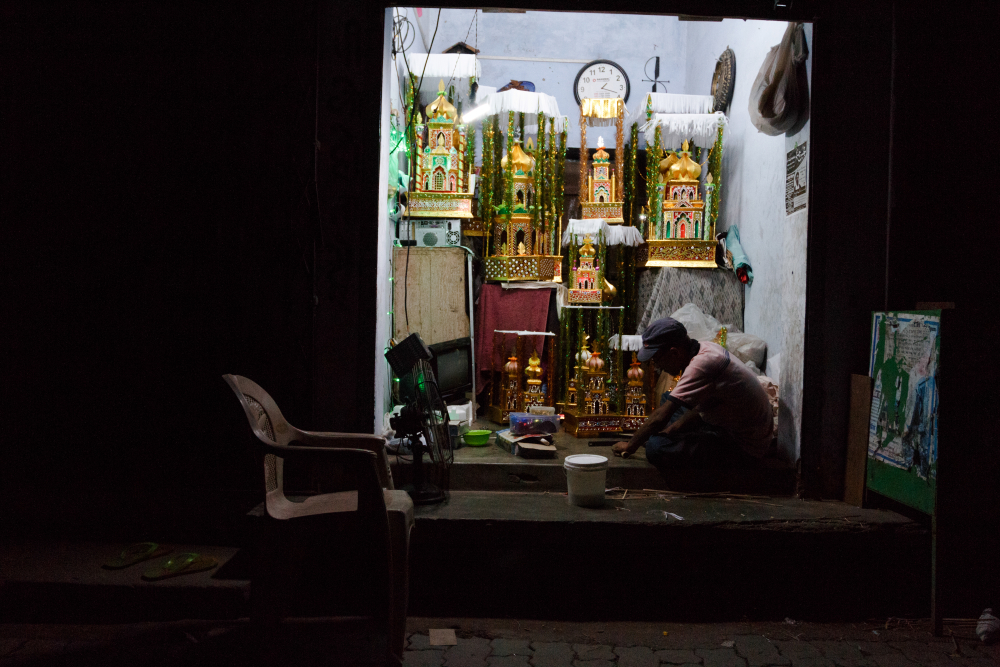
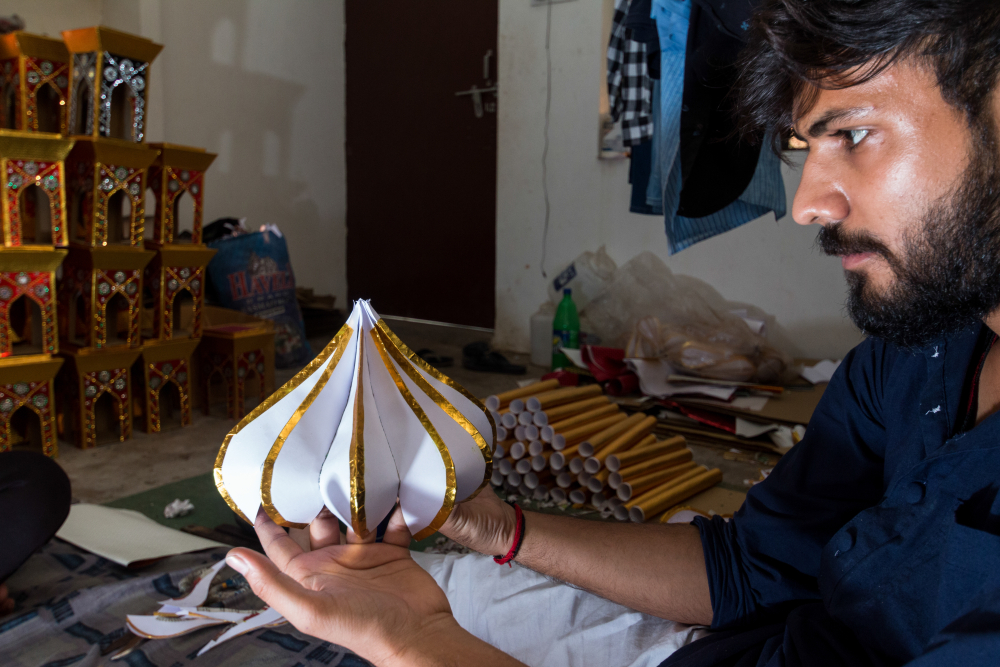
The Mirza family is renowned for its cardboard taziye, thus initially kamrakhi gumzi mostly adorned taziye made from cardboard though similar designs in bamboo can be seen on bamboo taziye as well. There are makers who are further modifying the already intricate kamrakhi gumzi; for instance, few years ago, Kashmiri Mohalla’s Syed Qasim Haider made a curved dome with kamrakhi patterns. (Fig. 5)
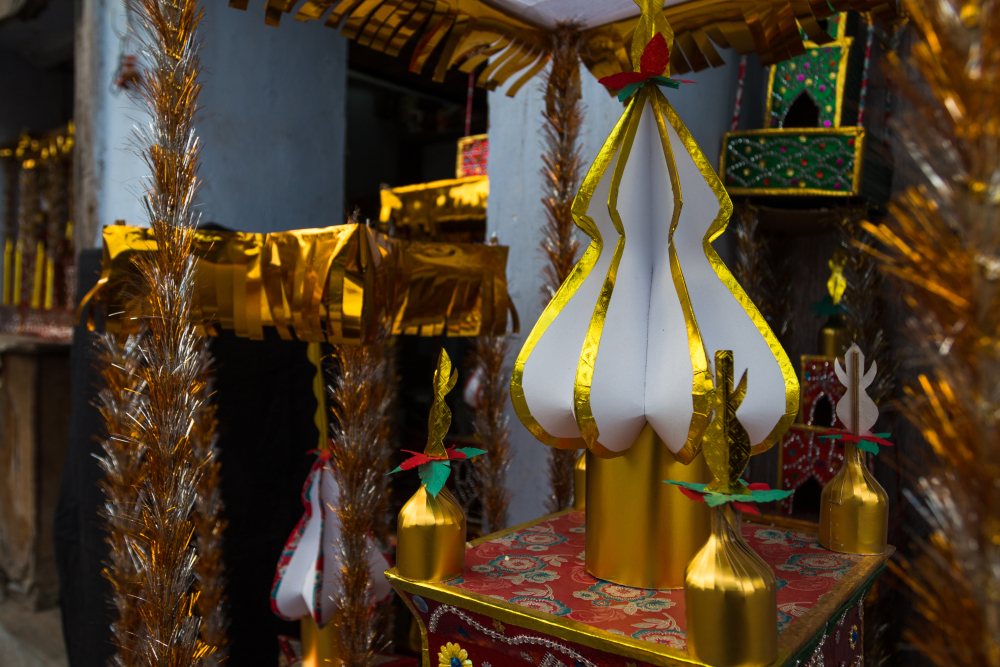
Makers like Raju in Kashmiri Mohalla have been experimenting with designs as well as raw materials such as taziya made from wedding cards. Two young boys, siblings Shoaib and Zuhair, are popular for their innovative taziya making; buyers are so in love with their taziye that their stocks sell out in a single night.
On the first day of Muharram, the main road of Kashmiri Mohalla is adorned with glittering lights, tents, and decorated taziye; here one can find taziya from the size of a palm to five feet. (Figs 6, 7 and 8)
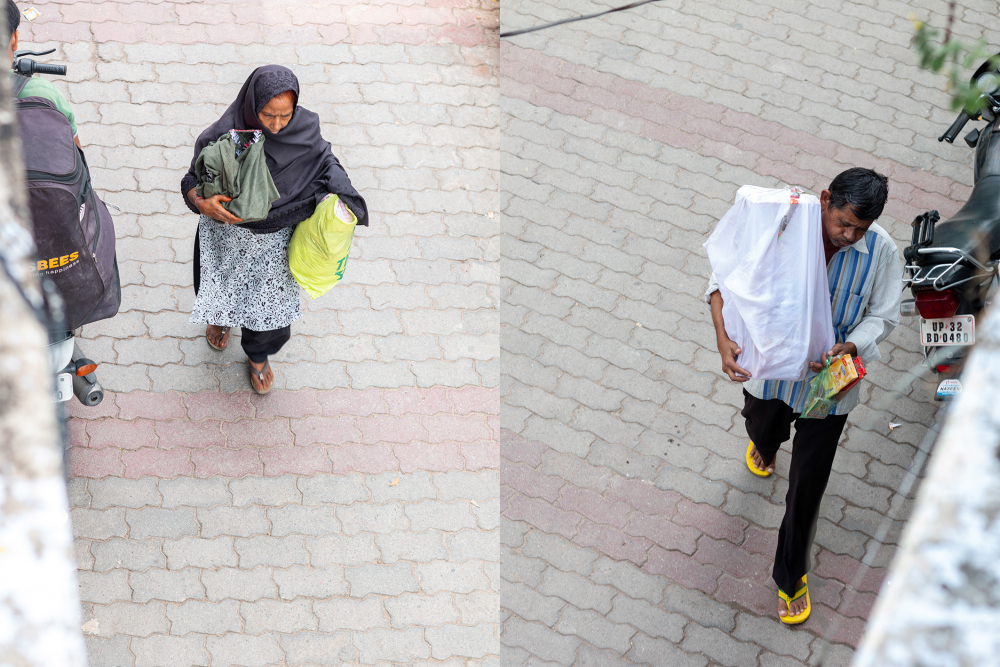
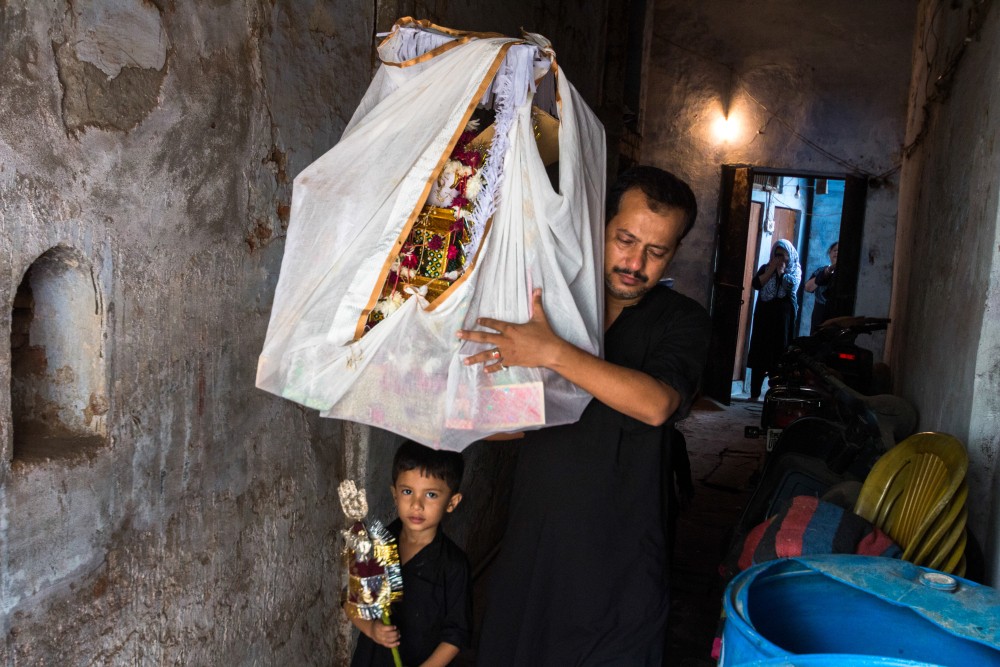
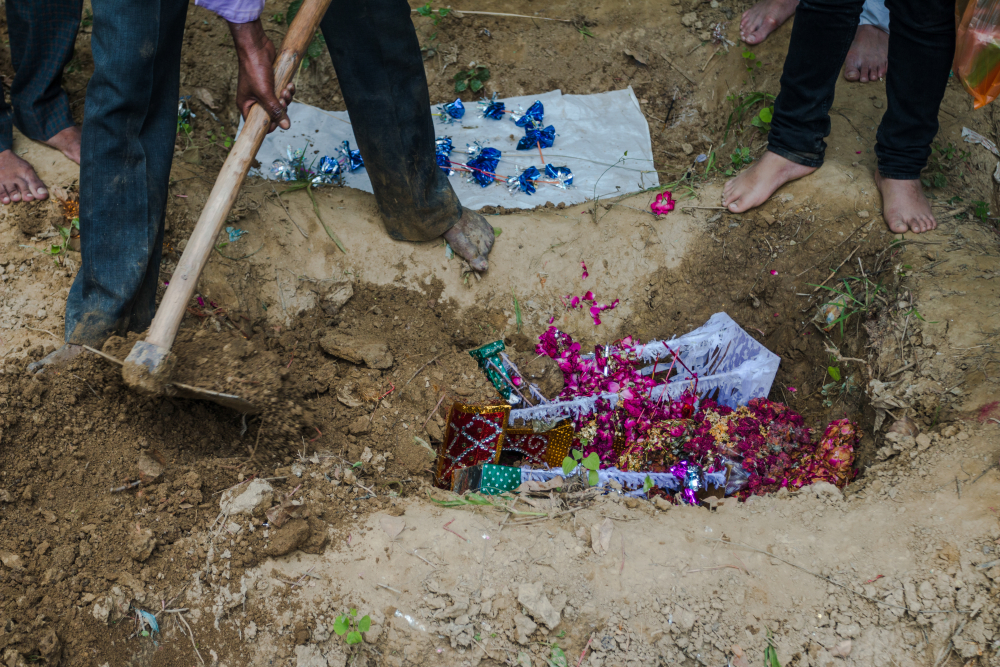
Tazia Making in Awadh
A more elaborate taziya making can be witnessed in Lucknow’s Chota Imambada. Months before Muharram artists from the Jarwal region in Bahraich occupy side arches of the imambada to prepare for what is probably the most famous structure in Lucknow azadari (mourning rituals and cultural depiction of the tragedy of Karbala), the Shahi Zarih. Popular for their bamboo taziye, Jarwal taziya artists are commissioned to make the shahi zarih, taziya and other azadari paraphernalia for Hussainabad Allied Trust under the care of district magistrate of Lucknow. A 21-feet tall zarih made of wax and bamboo and a 17-feet taziya of bamboo and arbak prepared by the makers become the face of the Shahi Juloos which sees people of all faiths in large numbers. (Fig. 9)
The tradition of the Shahi Zarih was started by Awadhi nawab Asif-ud-Daula’s son Wazir Ali Khan in 1795[1] and is also known as moom wali zarih (wax zarih) though now the use of wax is mostly on the exterior. Rubber moulds are used to make flowers and stars of wax on the zarih while wooden moulds are used for pillars. The Shahi Zarih is made in 11 parts and each part is almost the size of a large taziya and it weighs in quintals.
Historian S.A.A. Rizvi references in his book from the court writings of Nawab Asif-ud-Daula in 1794 that the nawab himself inspected taziya preparation. He ordered the superintendent of his treasure house, Tahsin Ali Khan to pay INR 5000 for the preparation of taziya, and Raja Bhawani Mishra (an Awadhi taluqdar) presented gold embroideries to the taziye.[2]
Taziya making was such a major craft during the Nawabi period that it gave rise to a separate group of artisans known as aaraishwala (decorator)[3] who were in demand in marriages and Muharram. William Hoey, a magistrate in Lucknow during the nineteenth century mentions aaraishwalas in relation to taziya making with bamboo, tinsel, brass, thread, and catgut.[4] The word aaraishwala can now only be rarely heard from senior karigars as decoration now is usually called sajawat (a more general Urdu word for decoration).
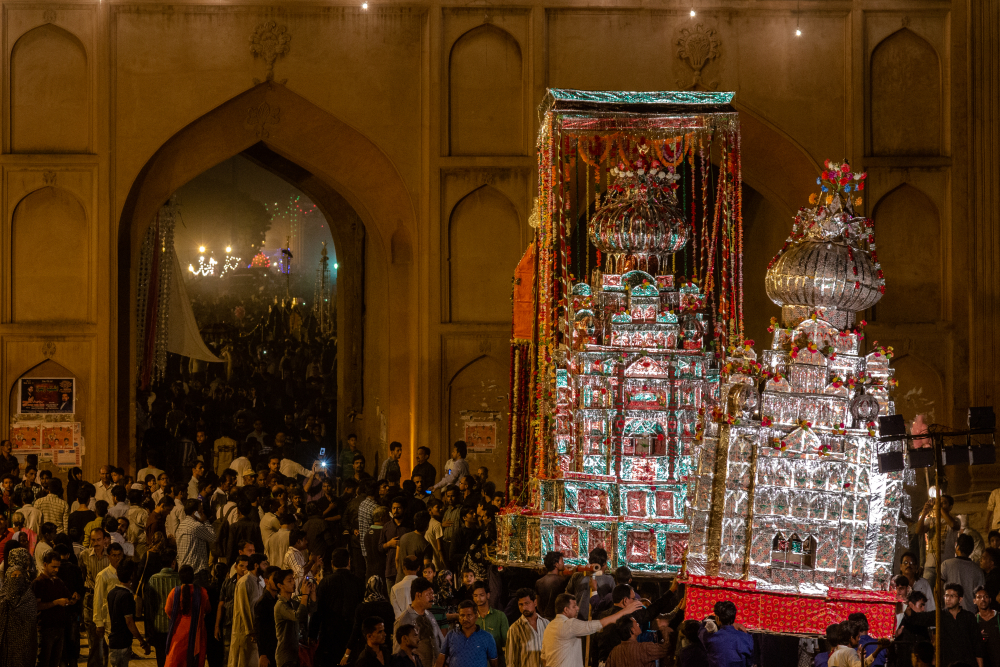
Biswan’s Taziye and the Taziya Makers of Kamapur
Moving away from the capital city, one reaches Sitapur district, probably the biggest taziya centre in central Uttar Pradesh. Biswan, a small town in the district, is famous all over the region for bamboo taziya making and Lucknow’s largest taziya market at Sultanul Madaris is dominated by the taziya of Biswan town; last year, a taziya of 35 feet made in Biswan was sold at INR 70,000. If one visits Biswan just before Muharram, one can see trucks loading taziye in parts to be taken to Gonda, Bahraich, Lakhimpur, Dewa, Lucknow, etc. It is not surprising that the Biswan taziya makers’ homes are chock full of taziye during business season.
Apart from bamboo, Biswan taziya makers also specialise in wooden and cardboard taziye; then there are karigars who make taziye out of thin plastic films, a replacement for paper that give the taziye a glossy effect.
However, Biswan’s taziya mastery is only part of the story, which is incomplete without the mention of Kamapur, a village about 11 km away from the town. With no access to pucca roads and most houses made with mud and thatched roofs, karigars of Kamapur produce bamboo taziye which are bought by the Biswan karigars who then decorate them with paper and other elements. Once embellished with decorative elements, these taziye are sold at an unimaginable margin of profit. Almost all the taziye of Biswan are made by the karigars from Kamapur. The condition of the village and standard of living in Kamapur is a clear indicator that these makers get meagre return of their work. The taziye they make passes to Biswan and from there to other parts of Uttar Pradesh and beyond. To people sitting in towns and cities, Biswan is the taziya centre but in true sense Kamapur deserves equal recognition.
Evolution of Taziya Making
The eighteenth and nineteenth century descriptions of the taziya by historians give us a basic idea of its design, size, and type, and it seems that most of the taziye were elaborate in construction. The texts however often fail to distinguish between the taziya and the rauza (shrine) and zarih (an elevated structure that surrounds a grave and gives it its identity), which are bigger and more decorated permanent structures kept in all imambade and personal azakhane, irrespective of Muharram. For example, describing the taziye she saw in the 1820s in Awadh, British history writer and memoirist Mrs Meer Hassan Ali, who lived in India for a decade in the early nineteenth century, notes, ‘the handsomest of the kind, to my taste, is in the possession of his majesty the King of Oudh, composed of green glass, with brass moldings, manufactured in England.’[5] She goes on to explain that the expensive taziye were generally permanent fixtures in imambade while the temporary taziye were made from bamboo frames. According to Ali, the taziye prices ranged from INR 2 to INR 200 in the market. However, what she mentions as elaborate permanent fixtures must have been rauza and zarih.
Taziya making has come a long way. Professor of Middle Eastern and Islamic Studies at NYU, Peter Chelkowski notes that once taziye were merely replicas of the Iranian nakhl (symbolic representation of the tomb and bier of Imam Hussain [a.s.]);[6] nowadays, made out of bamboo, abrak, cardboard and paper, the taziya might be seen by an onlooker as a high tower with sequins and other decorations; some might even compare it to an ornate Christmas tree, conical in shape, vibrant with colours and embellishments. (Fig. 10)
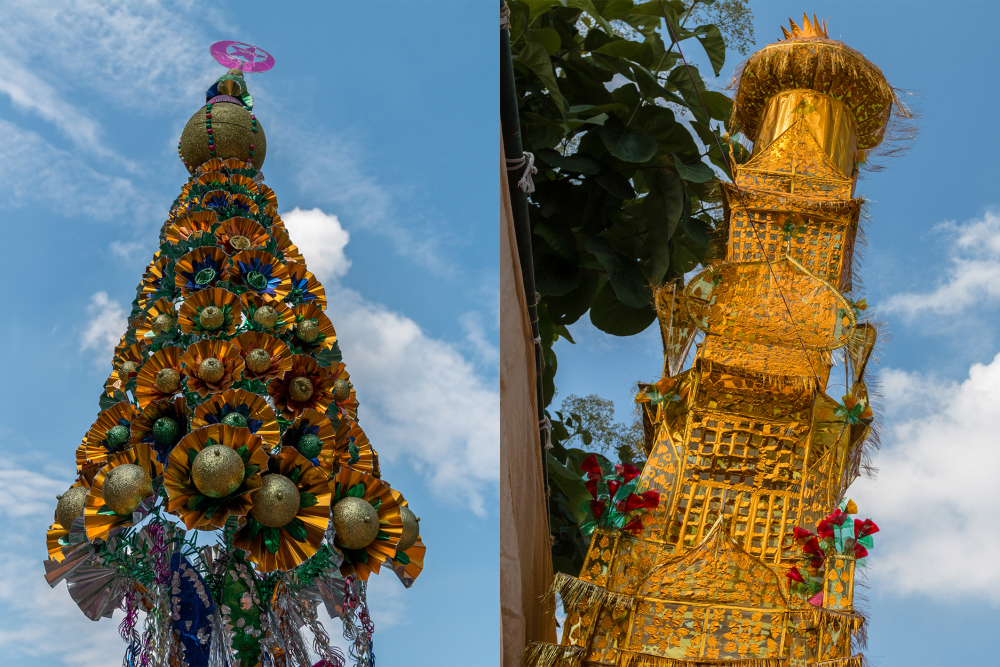
The cardboard taziya which finds no mention in various historical accounts seems to be a later innovation.[7] It is likely that cardboard taziye were the result of first-time taziya makers noticing cardboard’s sturdy nature when used as packaging material. Even today, part-time taziya makers or people who make it for their own use, recycle cartons to make cardboard taziya; for example, the mannati (prayer) taziya, which is the smallest taziya, is made mostly out of cigarette packets.
Taziya makers of both bamboo and cardboard style have been striving to improvise and compete in their own ways, from making taziye with plastic sheets to making domes of varied styles to making takhats (bases) of different shapes. Competition not only persists in terms of the design but also in terms of size; every year, a new region claims to have made the largest taziya for Muharram. Since the bamboo taziye are more diverse and spread across regions, we see more shapes, sizes, and design among them in comparison to cardboard taziye.
There are also eccentric innovators such as the jau ka (barley’s) taziya makers who are making the mausoleums with barley and wood. Abdul Mumtaz, a 75-year-old man from Narhai locality in Lucknow, is known for his jau ka taziya which he makes with the help of his family for Muharram. He even makes a miniature swing out of barley in remembrance of Hazrat Ali Asghar’s (a.s.) martyrdom, son of Imam Hussain who was six months old at the time of the battle of Karbala. (Fig 11) Similarly, there is also Kashmiri Mohalla’s Athar Hussain whose jau ka taziya is reserved for Chehlum.
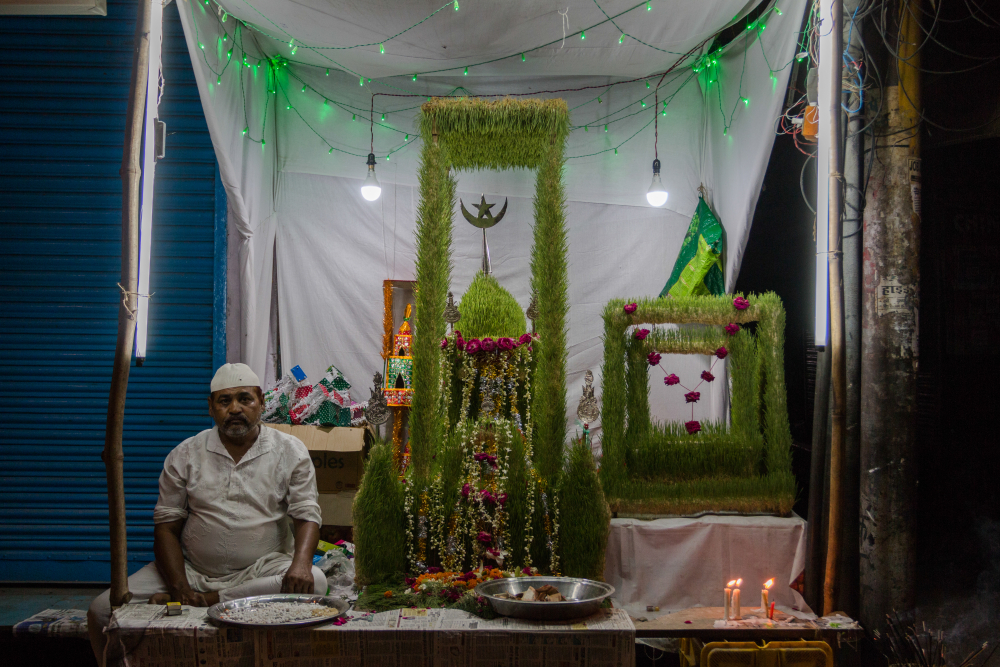
Notes
[1] Taqui, Lucknow ka Shia Samaj.
[2] Rizvi, A Socio-Intellectual History of the Shia Isna ' Ashari Shi'is in India (16th to 19th century A.D.).
[3] Cole, Roots of North Indian Shiism in Iran and Iraq: Religion and State in Awadh, 1722–1859.
[4] Hoey, A Monograph on Trade and Manufactures in Northern India.
[5] Ali, Observations on the Mussulmauns of India.
[6] Chelkowski, ‘NAḴL.’
[7] Roberts, Scenes and Characteristics of Hindostan.
Bibliography
Adshead, S. A. M. Central Asia in Word History. Hampshire: Palgrave, 1993.
Ali, Mrs Meer Hassan. Observations on the Mussulmauns of India. Vol. 1. New Delhi: Idara-i Adabiyat-i Delli, 2009.
Anwar, Iraj. 2005. 'Peripheral Ta'ziyeh: The transformation of Ta'ziyeh from Muharram mouring ritual to secular and comical theatre.' The MIT Press.
Banerji, S.K. 1935. Humayun's Religion. Lucknow: Indian History Congress.
Brown, Rebecca M. 'Abject to Object: Colonialism Preserved through the Imagery of Muharram.' The University of Chicago Press Journal 43 (2003): 203–17.
Casci, Simonetta. 2002. 'Lucknow Nawabs: Architecture and Identity.' Economic and Political Weekly 37, no. 36 (September, 2002): 3711–3714.
Chelkowski, Peter J. 'From the Sun-Scorched Desert of Iran to the Beaches of Trinidad: Taʿziyeh's Journey from Asia to the Caribbean.' TDR (1988–) 49, no. 4 (2005): 156–69.
———. Peter Chelkowski, 'NAḴL,' Encyclopædia Iranica. 2008. Accessed September 29, 2020. http://www.iranicaonline.org/articles/nakl-object-in-the-mourning-rituals
Cole, Jaun Ricardo. Roots of North Indian Shiism in Iran and Iraq: Religion and State in Awadh, 1722–1859. Berkeley: University of California Press, 1988.
Crooke, William. The North-Western Provinces of India. London: Methuen & Co, 1897.
Dasgupta, Partha. The Making of Becoming Amrit. Calcutta: Exhibition at Maya Art Gallery, 2015.
Firozuddin, Al Haaj Moulvi. 1987. Firoz ul Lughat Urdy Jadeed. Aligarh: Educational Book House, Aligarh.
Ghosh, Rajoshree. 'The Dynamics of a Mughal Court Festival: A Case Study of Nauroz.' Indian Historical Review 44, no. 2 (2017): 198–211.
Habib, Irfan. 'Timur in the Political Tradition and Historiograpy of Mughal India.' Indian History Congress 57 (1996): 289–303.
Hasan, Mushirul. 'Traditional Rites and Contested Meanings: Sectarian Strife in Colonial Lucknow.' Economic and Political Weekly 31, no. 9 (1996): 543–50.
Hoey, William. A Monograph on Trade and Manufactures in Northern India. Lucknow: American Methodist Mission Press, 1880.
Hollister, John Norman. 1979. The Shi'a of India. New Delhi: Oriental Books Reprint Corporation.
Hossain, Shakeel. 1990. 'Ta'zia: Ephemeral Architecture in India.' In Mimar 35: Architecture in Development, edited by Hasan-Uddin Khan. London: Concept Media Ltd., 1990.
Lal, Ruby. Empress: The Astonishing Reign of Nur Jahan. New York: W. W. Norton and Co, 2018.
Lyons, Tryna. 'Some Historic Ta'ziyas of Multan.' In People of the Prophet’s House: Artistic and Ritual Expressions of Shiʿi Islam, edited by Fahmida Suleman, 221–31. London: Azimuth Editions Publishers with Institute of Ismaili Studies, 2015.
Majlesi, Mohammad Baqer. Bihar Ul Anwar. Lucknow: Nizami Press, 2008.
Manz, Beatrice Forbes. The Rise and Rule of Tamerlane. Cambridge: Cambridge University Press, 1989.
Marozzi, Justin. Tamerlane: Sword of Islam, Conquerer of the World. London: Harper Press, 2005.
Mousavi, Ahmed Kazemi. 'Shi'ite Culture.' Iranian Studies 31, no. 3/4 (1998): 639–58.
Moreland, W. H., and P. Geyl, eds. and trans. Jahangir's India: The Remonstrantie of Francis Palsaert. Cambridge: W. Heffer and Sons Ltd, 1925.
Naqvi, Mazhar. 'Tazia Making: Unique Craft with Multicultural Understanding.' Heritage Guru. 2014. Accesed September 29, 2020. http://vsgoi.blogspot.com/2014/10/tazia-making-unique-craft-with.html.
Naqvi, Syed Ali Naqi. Shaheed e Insaniyat. Lucknow: Nami Press, 1995.
Naqvi, Syed Hasan Zafar. ‘History of Chup Tazia Juloos in Indo-Pak subcontinent.’ YouTube video, 21:17. October 31, 2019. Accessed October 2, 2020. https://youtu.be/KJnh2KuvAtA
Rizvi, Sayyid Athar Abbas. A Socio-Intellectual History of the Shia Isna ' Ashari Shi'is in India (16th to 19th century A.D.). Vol. 2. Canberra: Ma'rifat Publishing House, 1986.
Roberts, Emma. Scenes and Characteristics of Hindostan. Vol. 1. London: Wm. H. Allen and Co., 1837.
Rizvi, S.N.R., and Poonam Pant. 'Nauroz: A Court Festival of Medieval India.' Proceedings of the Indian History Congress 63 (2002): 289–98.
Shah, Syed Shahid Ali. Azadari: Culture of Mourning. Lahore: Izhar Sons, 2002.
Taqui, Roshan. Lucknow ka Shia Samaj (Hindi). Lucknow: Hindi Wangmaye Nidhi, 2015.
Vassiliev, Alexei. The History of Saudi Arabia. London: Saqi Books, 2000.
